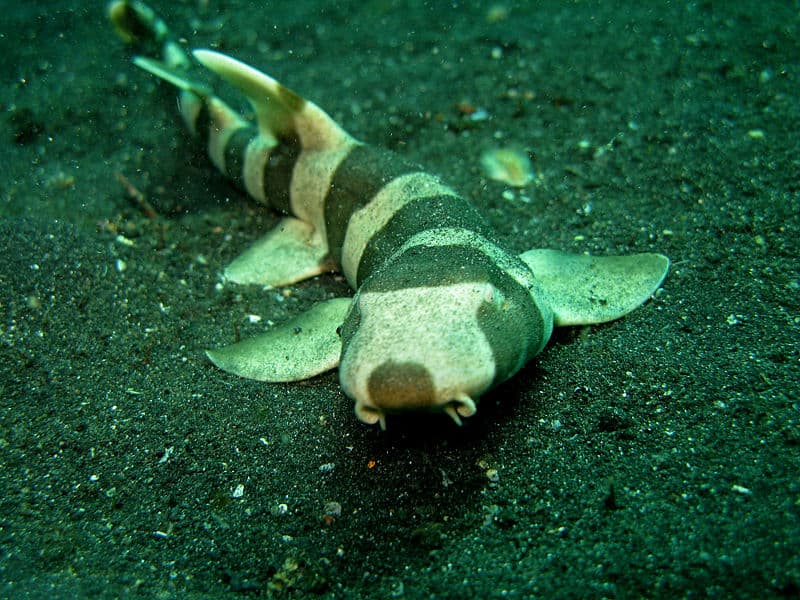Physical description
- Body length at about 40 inches/maximum length 105cm
- Slender body with elongated tail
- Dorsal fins are of equal size
- Mouth is in front the eyes and it has spiracles both below and behind them.
- Young sharks, like the one shown here, are banded beautifully. Adults are light brown and their banding seems to fade as they get older.
For more information on keeping marine fish see: Guide to a Happy, Healthy Marine Aquarium
General information
These sharks live around coral reefs and tidepools. Interestingly, it can survive out of water for up to 12 hours. The catshark family contains many species, usually distinguished by their different markings of stripes, bars, etc. Interestingly enough, the best known of the catshark family is the dogfishes (which form a part of the catshark family). On the internet, brown-banded bamboo cat sharks are for sale, and it is clear that some people might attempt to keep them in their own aquariums. Bamboo sharks are egg-layers, with the eggs enclosed in elongated flattened egg-cases. In captivity, hatching can take up to four months.
Special anatomical, physiological or behavioral adaptations
These sharks are not endangered at the moment. They tend to stay inshore near coral reefs and tidepools; however, they have fallen prey to fisheries in India and Thailand.
Also interesting is the fact that the gills of this shark are sometimes infested with the larva of isopods which is utilized as food. (The spiracles may be an adaptation for bottom dwelling which helps keep the sand out of the gills as the shark feeds).
These cat sharks have small “whiskers” which are called barbels. These are sensory organs which hang from each nostril.
Though they are sharks, they are harmless to people, but if kept in a tank, smaller fish…BEWARE!

Comments about the banded cat shark at the Fort Worth Zoo
The Fort Worth Zoo has one male brown-banded cat shark which they received as a donation on February 28, 1994. According to the zoo keepers, these sharks tend to breed fairly well, but the zoo discourages the public from keeping sharks in a home aquarium. If you look closely at the picture above, you can see the faded stripes of what once was a beautifully banded cat shark.
Personal Observations
When I first saw the banded cat shark at the zoo, I had a hard time understanding why they called it that. But, now after seeing the young cat sharks and the beautiful markings, I understand its name.
Also note that the males have claspers that are located under the anal fins and as they grow older the claspers become more pronounced. The females do not have these, so distinguishing a male from a female is easy!
Source Materials and Related Links
One book source is entitled: Fish, by Maurice and Robert Burton, Octopus Books Limited, published in 1975.
Here are several related on-line sources for sharks:
- Chiloscyllium punctatum (Muller & Henle, 1838) Brownbanded bambooshark, Fishbase
- Stan & Debbie Hauter, Brownbanded Bamboo Shark Profile, Saltwater.about.com
- Callie Matthews, Banded Cat Shark (Brownbanded Bamboo Shark), WhoZoo.org
Bamboo_Shark (Image Credit: Steve Childs, Wikimedia Commons CC BY-SA 2.0 Generic)
